Progress and Developments in the Fabrication and Characterization of Metal Halide Perovskites for Photovoltaic Applications
Abstract
1. Introduction
2. Characterization Techniques
2.1. Structural Characterization
2.2. Morphological Analysis
2.3. Optical Characterization
2.4. Electrical and Dielectric Measurements
2.5. Integration of Emerging Techniques
3. Synthesis Methods for Metal Halide Perovskites
3.1. Solution-Based Synthesis
3.1.1. Sol–Gel Method
3.1.2. Spin-Coating and Dip-Coating
3.1.3. Ligand-Assisted Reprecipitation (LARP)
3.2. Vapor-Phase Deposition Techniques
3.2.1. Thermal Evaporation
3.2.2. Chemical Vapor Deposition (CVD)
3.3. Nanostructuring Approaches
3.3.1. Colloidal Synthesis
3.3.2. Template-Assisted Growth
3.4. Comparative Analysis of Synthesis Methods
4. Optimization of Metal Halide Perovskites for Photovoltaics
5. Machine Learning and AI in Perovskite Research
6. Performance Metrics of Perovskite Solar Cells
7. Applications Beyond Photovoltaics
8. Future Directions and Challenges
9. Conclusions and Perspectives
Author Contributions
Funding
Data Availability Statement
Acknowledgments
Conflicts of Interest
References
- Miao, Z.; Meng, X.; Li, X.; Liang, B.; Watanabe, H. Enhancement of net output power of thermoelectric modules with a novel air-water combination. Appl. Therm. Eng. 2025, 258, 124745. [Google Scholar] [CrossRef]
- Gao, C.; Zhu, J.; Ye, S.; Li, M.; Wang, H.; He, J. Novel high-entropy perovskite titanate: A potential thermal protective material with improved thermophysical properties. J. Eur. Ceram. Soc. 2025, 45, 116878. [Google Scholar] [CrossRef]
- Liu, W.; Wu, Y.; Bao, X.; Sun, L.; Xie, Y.; Chen, Y. High-Performance Infrared Self-Powered Photodetector Based on 2D Van der Waals Heterostructures. Adv. Funct. Mater. 2025, 2421525. [Google Scholar] [CrossRef]
- Sun, K.; Liu, S.; Gao, Y.; Du, H.; Cheng, D.; Wang, Z. Output power prediction of stratospheric airship solar array based on surrogate model under global wind field. Chin. J. Aeronaut. 2024, 38, 103244. [Google Scholar] [CrossRef]
- Li, K.; Zhu, Y.; Chang, X.; Zhou, M.; Yu, X.; Zhao, X.; Wang, T.; Cai, Z.; Zhu, X.; Wang, H.; et al. Self-Induced Bi-interfacial Modification via Fluoropyridinic Acid For High-Performance Inverted Perovskite Solar Cells. Adv. Energy Mater. 2024, 15, 2404335. [Google Scholar] [CrossRef]
- Hao, R.; Zhu, L.; Shang, T.; Xu, Z.; Wu, Q. Strong absorption of silica over full solar spectrum boosted by interfacial junctions and light–heat–storage of Mg(OH)2–(CrOx–SiO2). Chem. Eng. J. 2024, 497, 154979. [Google Scholar] [CrossRef]
- Su, J.; Yang, X.; Yao, Y.; Long, J.; Zhang, H.; Wang, C.; Li, Z.; Zhang, X.; Hou, L.; Fan, W. Advanced three-dimensional textile technique for fabrication of sisal/flax hybrid fiber green biocomposite with enhanced mechanical, thermal, and sound isolation properties. Ind. Crops Prod. 2025, 223, 120174. [Google Scholar] [CrossRef]
- Lu, L.; Liu, X.; Sun, Y.; Wang, S.; Liu, J.; Ge, S.; Wei, T.; Zhang, H.; Su, J.; Zhang, Y.; et al. Silk-Fabric Reinforced Silk for Artificial Bones. Adv. Mater. 2024, 36, e2308748. [Google Scholar] [CrossRef]
- Li, N.; Hu, X.; Tang, Y.; Lei, Y.; Lau, Y.S.; Chen, Q.; Sui, X.; Zhu, F. Perovskite/organic tandem device to realize light detection and emission dual function. Chem. Eng. J. 2024, 490, 151573. [Google Scholar] [CrossRef]
- Jia, S.; Li, Y.; Gao, C.; Liu, G.; Ren, Y.; He, C.; An, X.-T. Realization of p-type MA-based perovskite solar cells based on exposure of the (002) facet. Appl. Phys. Lett. 2025, 126, 023908. [Google Scholar] [CrossRef]
- Gao, C.; Jia, S.; Yin, X.; Li, Z.; Yang, G.; Chen, J.; Li, Z.; An, X.-T. Enhancing open-circuit voltage in FAPbI3 perovskite solar cells via self-formation of coherent buried interface FAPbIxCl3−x. Chem. Commun. 2025, 61, 2758–2761. [Google Scholar] [CrossRef] [PubMed]
- Tayari, F.; Teixeira, S.S.; Graca, M.P.F.; Nassar, K.I. A Comprehensive Review of Recent Advances in Perovskite Materials: Electrical, Dielectric, and Magnetic Properties. Inorganics 2025, 13, 67. [Google Scholar] [CrossRef]
- Dhahri, R.; Albargi, H.B.; Jbeli, A.; Elkenany, E.B.; Althumairi, N.A.; Al-Syadi, A.M.; Sharma, N.; Lal, M.; Nassar, K.I. Enhanced electrical and magnetic properties of barium manganese titanium oxide perovskite ceramics synthesized by solid-state reaction. J. Mater. Sci. Mater. Electron. 2024, 36, 1–14. [Google Scholar] [CrossRef]
- Dhahri, R.; Tayari, F.; Albargi, H.B.; Elkenany, E.B.; Al-Syadi, A.M.; Sharma, N.; Lal, M.; Nassar, K.I. Comprehensive analysis of structural, dielectric, and electrical properties of sol-gel synthesized Ba-doped bismuth ferric titanate perovskite nanoparticles. J. Mater. Sci. Mater. Electron. 2024, 35, 1–17. [Google Scholar] [CrossRef]
- Tayari, F.; Teixeira, S.S.; Graça, M.P.F.; Essid, M.; Nassar, K.I. Investigating structural, dielectric, and electrical characteristics of sol–gel synthesized perovskite ceramic Bi0.7Ba0.3(FeTi)0.5O3. J. Sol-Gel Sci. Technol. 2024, 112, 601–613. [Google Scholar] [CrossRef]
- Tayari, F.; Benamara, M.; Lal, M.; Essid, M.; Thakur, P.; Kumar, D.; Teixeira, S.S.; Graça, M.P.F.; Nassar, K.I. Exploring Enhanced Structural and Dielectric Properties in Ag-Doped Sr(NiNb)0.5O3 Perovskite Ceramic for Advanced Energy Storage. Ceramics 2024, 7, 958–974. [Google Scholar] [CrossRef]
- Al-Amri, A.M.; Cheng, B.; He, H., Jr. Perovskite methylammonium lead trihalide heterostructures: Progress and challenges. IEEE Trans. Nanotechnol. 2018, 18, 1–12. [Google Scholar] [CrossRef]
- Yu, Z.; Zhao, J.; Markov, V.; Han, D. Effects of hydrogen addition on ignition characteristics and engine performance of ammonia-hydrogen blended fuel: A kinetic analysis. Int. J. Hydrogen Energy 2024, 87, 722–735. [Google Scholar] [CrossRef]
- Ye, J.; Gao, Y.; Gao, H.; Zhao, Q.; Xu, D.; Zhou, M.; Shi, M.; Xue, X. Effects of pristine and photoaged tire wear particles and their leachable additives on key nitrogen removal processes and nitrous oxide accumulation in estuarine sediments. J. Hazard. Mater. 2025, 487, 137136. [Google Scholar] [CrossRef]
- Zhang, B.W.; Lin, C.; Nirantar, S.; Han, E.; Zhang, Y.; Wang, Z.; Lyu, M.; Wang, L. Lead-Free Perovskites and Metal Halides for Resistive Switching Memory and Artificial Synapse. Small Struct. 2024, 5, 2300524. [Google Scholar] [CrossRef]
- Jana, A.; Cho, S.; Meena, A.; Ahmed, A.T.A.; Sree, V.G.; Park, Y.; Kim, H.; Im, H.; Taylor, R.A. Stabilization of halide perovskites with silicon compounds for optoelectronic, catalytic, and bioimaging applications. InfoMat 2024, 6, e12559. [Google Scholar] [CrossRef]
- Wu, H.; Zhang, H.; Yan, R.; Li, S.; Guo, X.; Qiu, L.; Yao, Y. Limosilactobacillus Regulating Microbial Communities to Overcome the Hydrolysis Bottleneck with Efficient One-Step Co-Production of H2 and CH4. Adv. Sci. 2024, 11, e2406119. [Google Scholar] [CrossRef] [PubMed]
- Zhang, D.; Liu, X.; Chen, Y.; Xia, Y.; Tang, Y.; Wang, H.; Ni, Y. Universal Surface-Defect Passivant for Perovskite Solar Cells Based on N -Phenylglycine for Improved Photovoltaic Performance and Stability. Phys. Rev. Appl. 2022, 17, 024039. [Google Scholar] [CrossRef]
- Gao, D.; Liu, S.; Gao, Y.; Li, P.; Zhang, H.; Wang, M.; Yan, S.; Wang, L.; Zhang, Y. A Comprehensive Adaptive Interpretable Takagi–Sugeno–Kang Fuzzy Classifier for Fatigue Driving Detection. IEEE Trans. Fuzzy Syst. 2024, 33, 108–119. [Google Scholar] [CrossRef]
- Yao, Y.; Chen, S. A novel and simple approach to the good process performance of methane recovery from lignocellulosic biomass alone. Biotechnol. Biofuels 2016, 9, 1–9. [Google Scholar] [CrossRef]
- Kumari, M.A.; Swetha, T.; Singh, S.P. Fullerene derivatives: A review on perovskite solar cells. Mater. Express 2018, 8, 389–406. [Google Scholar] [CrossRef]
- Golia, S.S.; Puri, C.; Zargar, R.A.; Arora, M. Synthesis and Characterization of Metal Oxide Nanoparticles/Nanocrystalline Thin Films for Photovoltaic Application. In Metal Oxide Nanocomposite Thin Films for Optoelectronic Device Applications; Wiley: Hoboken, NJ, USA, 2023; pp. 1–44. [Google Scholar] [CrossRef]
- Ouyang, Y.; Jiang, M.; Wang, T.; Li, L.; Cheng, S.; Xu, Y.; Zeng, Y.; Cao, S.; Song, J.; Rao, G. Improvement of structure and electrical properties of multiple elements co-doped KNN crystals grown by SFSSCG method. Mater. Today Commun. 2024, 42, 111119. [Google Scholar] [CrossRef]
- Zhu, B.; Zhu, Y.; Yang, J.; Ou-Yang, J.; Yang, X.; Li, Y.; Wei, W. New Potassium Sodium Niobate Single Crystal with Thickness-independent High-performance for Photoacoustic Angiography of Atherosclerotic Lesion. Sci. Rep. 2016, 6, 39679. [Google Scholar] [CrossRef]
- Lin, C.; Li, K.; Li, M.; Dopphoopha, B.; Zheng, J.; Wang, J.; Du, S.; Li, Y.; Huang, B. Pushing Radiative Cooling Technology to Real Applications. Adv. Mater. 2024, e2409738. [Google Scholar] [CrossRef]
- Yu, B.; Tan, S.; Li, D.; Meng, Q. The stability of inorganic perovskite solar cells: From materials to devices. Mater. Futur. 2023, 2, 032101. [Google Scholar] [CrossRef]
- Thakur, P.; Kishore, K.; Kumar, R.; Pathak, D.; Nassar, K.I.; Lal, M. Structural, morphological, dielectric, and magnetic properties of CoFe2O4 ceramics at different sintering temperatures. J. Mater. Sci. Mater. Electron. 2024, 35, 1932. [Google Scholar] [CrossRef]
- Zhu, B.; Wang, Z.; Zhang, Y.; Yu, Z.; Shi, J.; Xiong, R. Low temperature fabrication of the giant dielectric material CaCu3Ti4O12 by oxalate coprecipitation m ethod. Mater. Chem. Phys. 2009, 113, 746–748. [Google Scholar] [CrossRef]
- Zhu, B.-P.; Tang, Z.; Zhao, L.-H.; Wang, L.-L.; Li, C.-Z.; Yin, D.; Yu, Z.-X.; Tang, W.-F.; Xiong, R.; Shi, J.; et al. Synthesis of Mg[Ti2]O4 by spark plasma sintering. Mater. Lett. 2006, 61, 578–581. [Google Scholar] [CrossRef]
- Zeng, Z.; Wang, Y.; Xie, Y.; Zhu, Z.; Yang, Y.; Ma, Y.; Hao, X.; Lee, C.; Cheng, Y.; Tsang, S. On the Ion Coordination and Crystallization of Metal Halide Perovskites by In Situ Dynamic Optical Probing. Small Methods 2023, 8, e2300899. [Google Scholar] [CrossRef]
- Zeng, Z.; Wang, Y.; Ding, S.; Li, Y.; Xiang, C.; Lee, C.; Cheng, Y.; Tsang, S. Imbalanced Surface Charge Induced Phase Segregation in Mixed Halide Perovskites. Adv. Funct. Mater. 2024, 2404255. [Google Scholar] [CrossRef]
- Zhu, B.P.; Guo, W.K.; Shen, G.Z.; Zhou, Q.; Shung, K.K. Structure and electrical properties of (111)-oriented Pb(Mg1/3Nb2/3)O3-PbZrO3-PbTiO3 thin film for ultra-high-frequency transducer applications. IEEE Trans. Ultrason. Ferroelectr. Freq. Control 2011, 58, 1962–1967. [Google Scholar] [CrossRef]
- Zhu, B.P.; Zhou, Q.F.; Shung, K.K.; Wei, Q.; Huang, Y.H. Sol-gel derived PMN-PT thick film for high frequency ultrasound transducer applications. In Proceedings of the 2009 IEEE International Ultrasonics Symposium, Rome, Italy, 20–23 September 2009; pp. 2197–2200. [Google Scholar]
- Zhu, B.P.; Zhou, Q.F.; Shi, J.; Shung, K.K.; Irisawa, S.; Takeuchi, S. Self-separated hydrothermal lead zirconate titanate thick films for high frequency transducer applications. Appl. Phys. Lett. 2009, 94, 102901. [Google Scholar] [CrossRef]
- Ghadiri, M.; Kang, A.K.; Gorji, N.E. XRD characterization of graphene-contacted perovskite solar cells: Moisture degradation and dark-resting recovery. Superlattices Microstruct. 2020, 146, 106677. [Google Scholar] [CrossRef]
- Tayari, F.; Nassar, K.I.; Benamara, M. Enhancing future technologies: Sol-Gel synthesis of Sr0.6Ag0.4MnO3 manganite perovskite. Open J. Chem. 2024, 10, 44–46. [Google Scholar]
- Zhu, B.P.; Wu, D.W.; Zhou, Q.F.; Shi, J.; Shung, K.K. Lead zirconate titanate thick film with enhanced electrical properties for high frequency transducer applications. Appl. Phys. Lett. 2008, 93, 012905. [Google Scholar] [CrossRef]
- Tan, W.L.; McNeill, C.R. X-ray diffraction of photovoltaic perovskites: Principles and applications. Appl. Phys. Rev. 2022, 9, 021310. [Google Scholar] [CrossRef]
- Zhu, B.; Chan, N.Y.; Dai, J.; Shung, K.K.; Takeuchi, S.; Zhou, Q. New fabrication of high-frequency (100-MHz) ultrasound PZT film kerfless linear array [Correspondence]. IEEE Trans. Ultrason. Ferroelectr. Freq. Control 2013, 60, 854–857. [Google Scholar] [CrossRef] [PubMed]
- Benamara, M.; Nassar, K.I.; Rivero-Antúnez, P.; Essid, M.; Teixeira, S.S.; Zhao, S.; Serrà, A.; Esquivias, L. Study of electrical and dielectric behaviors of copper-doped zinc oxide ceramic prepared by spark plasma sintering for electronic device applications. Nanomaterials 2024, 14, 402. [Google Scholar] [CrossRef]
- Zhu, B.P.; Wu, D.W.; Zhang, Y.; Ou-Yang, J.; Chen, S.; Yang, X.F. Sol-gel derived PMN–PT thick films for high frequency ultraswound linear array applications. Ceram. Int. 2013, 39, 8709–8714. [Google Scholar] [CrossRef]
- Zhu, B.P.; Li, D.D.; Zhou, Q.F.; Shi, J.; Shung, K.K. Piezoelectric PZT thick films on LaNiO3buffered stainless steel foils for flexible device applications. J. Phys. D Appl. Phys. 2008, 42, 025504. [Google Scholar] [CrossRef] [PubMed]
- Mahmud, A.; Zheng, J.; Tang, S.; Wang, G.; Bing, J.; Bui, A.D.; Qu, J.; Yang, L.; Liao, C.; Chen, H.; et al. Cation-Diffusion-Based Simultaneous Bulk and Surface Passivations for High Bandgap Inverted Perovskite Solar Cell Producing Record Fill Factor and Efficiency. Adv. Energy Mater. 2022, 12, 2201672. [Google Scholar] [CrossRef]
- Duan, L.; Zhang, H.; Liu, M.; Grätzel, M.; Luo, J. Phase-Pure γ-CsPbI3for Efficient Inorganic Perovskite Solar Cells. ACS Energy Lett. 2022, 7, 2911–2918. [Google Scholar] [CrossRef]
- Zhou, Q.; He, D.; Zhuang, Q.; Liu, B.; Li, R.; Li, H.; Zhang, Z.; Yang, H.; Zhao, P.; He, Y.; et al. Revealing Steric-Hindrance-Dependent Buried Interface Defect Passivation Mechanism in Efficient and Stable Perovskite Solar Cells with Mitigated Tensile Stress. Adv. Funct. Mater. 2022, 32, 2205507. [Google Scholar] [CrossRef]
- Von Hauff, E.; Klotz, D. Impedance spectroscopy for perovskite solar cells: Characterisation, analysis, and diagnosis. J. Mater. Chem. C 2022, 10, 742–761. [Google Scholar] [CrossRef]
- Matacena, I.; Guerriero, P.; Lancellotti, L.; Alfano, B.; De Maria, A.; La Ferrara, V.; Mercaldo, L.V.; Miglietta, M.L.; Polichetti, T.; Rametta, G.; et al. Impedance Spectroscopy Analysis of Perovskite Solar Cell Stability. Energies 2023, 16, 4951. [Google Scholar] [CrossRef]
- Ghahremanirad, E.; Almora, O.; Suresh, S.; Drew, A.A.; Chowdhury, T.H.; Uhl, A.R. Beyond Protocols: Understanding the Electrical Behavior of Perovskite Solar Cells by Impedance Spectroscopy. Adv. Energy Mater. 2023, 13, 2204370. [Google Scholar] [CrossRef]
- Zhang, T.; Ou-Yang, J.; Yang, X.; Zhu, B. Transferred PMN-PT Thick Film on Conductive Silver Epoxy. Materials 2018, 11, 1621. [Google Scholar] [CrossRef]
- Khalifa, M.; Dkhili, M.; Aouida, S.; Ezzaouia, H. Optimizing electron transport layers for high-efficiency perovskite solar cells using impedance spectroscopy. Sol. Energy Mater. Sol. Cells 2024, 278, 113196. [Google Scholar] [CrossRef]
- Roose, B.; Dey, K.; Fitzsimmons, M.R.; Chiang, Y.-H.; Cameron, P.J.; Stranks, S.D. Electrochemical Impedance Spectroscopy of All-Perovskite Tandem Solar Cells. ACS Energy Lett. 2024, 9, 442–453. [Google Scholar] [CrossRef]
- Wang, D.; Ou-Yang, J.; Guo, W.; Yang, X.; Zhu, B. Novel fabrication of PZT thick films by an oil-bath based hydrothermal method. Ceram. Int. 2017, 43, 9573–9576. [Google Scholar] [CrossRef]
- Parikh, N.; Akin, S.; Kalam, A.; Prochowicz, D.; Yadav, P. Probing the Low-Frequency Response of Impedance Spectroscopy of Halide Perovskite Single Crystals Using Machine Learning. ACS Appl. Mater. Interfaces 2023, 15, 27801–27808. [Google Scholar] [CrossRef] [PubMed]
- Kadiwala, S.; Pandey, S.V.; Purohit, D.; Hirpara, D.; Akin, S.; Mahapatra, A.; Prochowicz, D.; Yadav, P. In-Line Electrochemical Impedance Spectroscopy for Real-Time Circuit Identification and Interpretation in Metal Halide Perovskite Single Crystals. J. Phys. Chem. C 2024, 128, 9776–9784. [Google Scholar] [CrossRef]
- Zhao, L.-C.; Tang, M.; Zhang, Q.-H.; Hu, Z.-Y.; Gao, H.-W.; Liao, X.-Y.; Wang, G.; Leng, J. Fabrication of a Porous Metal-Organic Framework with Polar Channels for 5-Fu Delivery and Inhibiting Human Osteosarcoma Cells. J. Chem. 2018, 2018, 1–7. [Google Scholar] [CrossRef]
- Clarke, W.; Cameron, P.; Richardson, G. Predicting Long-Term Stability from Short-Term Measurement: Insights from Modeling Degradation in Perovskite Solar Cells during Voltage Scans and Impedance Spectroscopy. J. Phys. Chem. Lett. 2024, 15, 11730–11736. [Google Scholar] [CrossRef]
- Pathak, C.S.; Chang, B.-J.; Song, S. Review on scanning probe microscopy analysis for perovskite materials and solar cells. Dyes Pigment. 2023, 218, 111469. [Google Scholar] [CrossRef]
- Zhou, Y.; Herz, L.M.; Jen, A.K.-Y.; Saliba, M. Advances and challenges in understanding the microscopic structure-property-performance relationship in perovskite solar cells. Nat. Energy 2022, 7, 794–807. [Google Scholar] [CrossRef]
- Lee, W.; Yoo, Y.J.; Park, J.; Ko, J.H.; Kim, Y.J.; Yun, H.; Kim, D.H.; Song, Y.M.; Kim, D.-H. Perovskite microcells fabricated using swelling-induced crack propagation for colored solar windows. Nat. Commun. 2022, 13, 1946. [Google Scholar] [CrossRef]
- Zhao, L.-C.; Liang, J.; Li, W.; Cheng, K.-M.; Xia, X.; Deng, X.; Yang, G.-L. The Use of Response Surface Methodology to Optimize the Ultrasound-Assisted Extraction of Five Anthraquinones from Rheum palmatum L. Molecules 2011, 16, 5928–5937. [Google Scholar] [CrossRef] [PubMed]
- Tong, J.; Jiang, Q.; Ferguson, A.J.; Palmstrom, A.F.; Wang, X.; Hao, J.; Dunfield, S.P.; Louks, A.E.; Harvey, S.P.; Li, C.; et al. Carrier control in Sn–Pb perovskites via 2D cation engineering for all-perovskite tandem solar cells with improved efficiency and stability. Nat. Energy 2022, 7, 642–651. [Google Scholar] [CrossRef]
- Sveinbjörnsson, K.; Li, B.; Mariotti, S.; Jarzembowski, E.; Kegelmann, L.; Wirtz, A.; Fru, F.; Weihrauch, A.; Niemann, R.; Korte, L.; et al. Monolithic perovskite/silicon tandem solar cell with 28.7% efficiency using industrial silicon bottom cells. ACS Energy Lett. 2022, 7, 2654–2656. [Google Scholar] [CrossRef]
- Yang, Z.Q.; Zhu, Y.Y.; Zou, D.; Liao, L.P. Activity Degree Evaluation of Glacial Debris Flow along International Karakorum Highway (KKH) Based on Fuzzy Theory. Adv. Mater. Res. 2011, 261–263, 1167–1171. [Google Scholar] [CrossRef]
- Su, H.; Lin, X.; Wang, Y.; Liu, X.; Qin, Z.; Shi, Q.; Han, Q.; Zhang, Y.; Han, L. Stable perovskite solar cells with 23.12% efficiency and area over 1 cm2 by an all-in-one strategy. Sci. China Chem. 2022, 65, 1321–1329. [Google Scholar] [CrossRef]
- Paik, M.J.; Yoo, J.W.; Park, J.; Noh, E.; Kim, H.; Ji, S.-G.; Kim, Y.Y.; Seok, S.I. SnO2–TiO2 Hybrid Electron Transport Layer for Efficient and Flexible Perovskite Solar Cells. ACS Energy Lett. 2022, 7, 1864–1870. [Google Scholar] [CrossRef]
- Zhou, Y.; Sternlicht, H.; Padture, N.P. Transmission electron microscopy of halide perovskite materials and devices. Joule 2019, 3, 641–661. [Google Scholar] [CrossRef]
- Wu, X.; Ke, X.; Sui, M. Recent progress on advanced transmission electron microscopy characterization for halide perovskite semiconductors. J. Semicond. 2022, 43, 041106. [Google Scholar] [CrossRef]
- Yang, Z.Q.; Zhu, H.L. Study on the effect of carbon nanotubes on the microstructure and anti-carbonation properties of cement-based materials. J. Funct. Mater. 2023, 54, 8217–8227. [Google Scholar]
- Dang, Z.; Shamsi, J.; Palazon, F.; Imran, M.; Akkerman, Q.A.; Park, S.; Bertoni, G.; Prato, M.; Brescia, R.; Manna, L. In Situ Transmission Electron Microscopy Study of Electron Beam-Induced Transformations in Colloidal Cesium Lead Halide Perovskite Nanocrystals. ACS Nano 2017, 11, 2124–2132. [Google Scholar] [CrossRef]
- Ran, J.; Dyck, O.; Wang, X.; Yang, B.; Geohegan, D.B.; Xiao, K. Electron-Beam-Related Studies of Halide Perovskites: Challenges and Opportunities. Adv. Energy Mater. 2020, 10, 1903191. [Google Scholar] [CrossRef]
- Yang, Z.Q.; Hou, K.; Cheng, Y.; Yang, B. Study of column-hemispherical penetration grouting mechanism based on power-law fluid. Chin. J. Rock. Mech. Eng. 2014, 33, 3840–3846. [Google Scholar] [CrossRef]
- Li, Y.; Zhou, W.; Li, Y.; Huang, W.; Zhang, Z.; Chen, G.; Wang, H.; Wu, G.-H.; Rolston, N.; Vila, R.; et al. Unravelling Degradation Mechanisms and Atomic Structure of Organic-Inorganic Halide Perovskites by Cryo-EM. Joule 2019, 3, 2854–2866. [Google Scholar] [CrossRef] [PubMed]
- Kodur, M.; Kumar, R.E.; Luo, Y.; Cakan, D.N.; Li, X.; Stuckelberger, M.; Fenning, D.P. X-Ray Microscopy of Halide Perovskites: Techniques, Applications, and Prospects. Adv. Energy Mater. 2020, 10, 1903170. [Google Scholar] [CrossRef]
- Yang, Z.; Zhao, X.; Chen, M.; Zhang, J.; Yang, Y.; Chen, W.; Bai, X.; Wang, M.; Wu, Q. Characteristics, Dynamic Analyses and Hazard Assessment of Debris Flows in Niumiangou Valley of Wenchuan County. Appl. Sci. 2023, 13, 1161. [Google Scholar] [CrossRef]
- Si, H.; Zhang, S.; Ma, S.; Xiong, Z.; Kausar, A.; Liao, Q.; Zhang, Z.; Sattar, A.; Kang, Z.; Zhang, Y. Emerging Conductive Atomic Force Microscopy for Metal Halide Perovskite Materials and Solar Cells. Adv. Energy Mater. 2020, 10, 1903922. [Google Scholar] [CrossRef]
- Ha, S.T.; Liu, X.; Zhang, Q.; Giovanni, D.; Sum, T.C.; Xiong, Q. Synthesis of Organic–Inorganic Lead Halide Perovskite Nanoplatelets: Towards High-Performance Perovskite Solar Cells and Optoelectronic Devices. Adv. Opt. Mater. 2014, 2, 838–844. [Google Scholar] [CrossRef]
- Rothmann, M.U.; Li, W.; Etheridge, J.; Cheng, Y.B. Microstructural characterisations of perovskite solar cells–from grains to interfaces: Techniques, features, and challenges. Adv. Energy Mater. 2017, 7, 1700912. [Google Scholar] [CrossRef]
- Shang, W.; Wang, C.; Wu, Z. Study of Hollow Nanoneedle’s Mechanical Performance by Nanorobotic Manipulation System. In Proceedings of the 2019 IEEE 14th International Conference on Nano/Micro Engineered and Molecular Systems (NEMS), Bangkok, Thailand, 11–14 April 2019; IEEE: Piscataway, NJ, USA, 2019. [Google Scholar]
- Park, B.-W.; Kedem, N.; Kulbak, M.; Lee, D.Y.; Yang, W.S.; Jeon, N.J.; Seo, J.; Kim, G.; Kim, K.J.; Shin, T.J.; et al. Understanding how excess lead iodide precursor improves halide perovskite solar cell performance. Nat. Commun. 2018, 9, 3301. [Google Scholar] [CrossRef] [PubMed]
- Kosasih, F.U.; Cacovich, S.; Divitini, G.; Ducati, C. Nanometric Chemical Analysis of Beam-Sensitive Materials: A Case Study of STEM-EDX on Perovskite Solar Cells. Small Methods 2020, 5, e2000835. [Google Scholar] [CrossRef] [PubMed]
- Meiqun, C.; Gui, Z.; Kehuan, S.; Zhengzhi, W. Application of bioinformatics technique to screen of differentially expressed proteins in serums of breast cancer patients with white and yellow coating. In Proceedings of the 2011 International Symposium on Information Technology in Medicine and Education (ITME 2011), Guangzhou, China, 9–11 December 2011; pp. 216–220. [Google Scholar]
- Kim, T.W.; Uchida, S.; Kim, M.; Cho, S.G.; Kim, S.J.; Kondo, T.; Segawa, H. Phase Control of Organometal Halide Perovskites for Development of Highly Efficient Solar Cells. ACS Appl. Mater. Interfaces 2023, 15, 21974–21981. [Google Scholar] [CrossRef]
- Lin, J.; Lai, M.; Dou, L.; Kley, C.S.; Chen, H.; Peng, F.; Sun, J.; Lu, D.; Hawks, S.A.; Xie, C.; et al. Thermochromic halide perovskite solar cells. Nat. Mater. 2018, 17, 261–267. [Google Scholar] [CrossRef] [PubMed]
- Tian, G.-H.; Tao, S.-S.; Chen, M.-T.; Li, Y.-S.; Li, Y.-P.; Shang, H.-C.; Tang, X.-Y.; Chen, J.-X.; Tang, H.-B. Electroacupuncture Treatment Alleviates Central Poststroke Pain by Inhibiting Brain Neuronal Apoptosis and Aberrant Astrocyte Activation. Neural Plast. 2016, 2016, 1–14. [Google Scholar] [CrossRef]
- Sutton, R.J.; Eperon, G.E.; Miranda, L.; Parrott, E.S.; Kamino, B.A.; Patel, J.B.; Hörantner, M.T.; Johnston, M.B.; Haghighirad, A.A.; Moore, D.T.; et al. Bandgap-Tunable Cesium Lead Halide Perovskites with High Thermal Stability for Efficient Solar Cells. Adv. Energy Mater. 2016, 6, 1502458. [Google Scholar] [CrossRef]
- Lei, Y.; Wang, S.; Xing, J.; Xu, H.; Han, J.; Liu, W. High-Performance UV–Vis Photodetectors Based on a Lead-Free Hybrid Perovskite Crystal (MV)[SbI3Cl2]. Inorg. Chem. 2020, 59, 4349–4356. [Google Scholar] [CrossRef]
- Cherrette, V.L.; Hutcherson, C.J.; Barnett, J.L.; So, M.C. Fabrication and Characterization of Perovskite Solar Cells: An Integrated Laboratory Experience. J. Chem. Educ. 2018, 95, 631–635. [Google Scholar] [CrossRef]
- Wu, Z.; Li, M.; Jia, X.; Zhang, Y. Influence of Tiantai No. 1 Recipe on learning and memory function of spontaneous Alzheimer disease models. Chin. J. Tissue Eng. Res. 2005, 53, 180–181. [Google Scholar]
- Tian, G.; Sun, Y.; Liu, S.; Li, C.; Chen, S.; Qiu, R.; Zhang, X.; Li, Y.; Li, M.; Shang, H. Therapeutic Effects of Wenxin Keli in Cardiovascular Diseases: An Experimental and Mechanism Overview. Front. Pharmacol. 2018, 9, 9. [Google Scholar] [CrossRef]
- Wu, X.; Zhou, B.; Zhou, J.; Chen, Y.; Chu, Y.; Huang, J. Distinguishable Detection of Ultraviolet, Visible, and Infrared Spectrum with High-Responsivity Perovskite-Based Flexible Photosensors. Small 2018, 14, e1800527. [Google Scholar] [CrossRef]
- Zhou, D.; Liu, D.; Pan, G.; Chen, X.; Li, D.; Xu, W.; Bai, X.; Song, H. Cerium and Ytterbium Codoped Halide Perovskite Quantum Dots: A Novel and Efficient Downconverter for Improving the Performance of Silicon Solar Cells. Adv. Mater. 2017, 29, 1704149. [Google Scholar] [CrossRef] [PubMed]
- Zheng, H.; Liu, G.; Chen, X.; Zhang, B.; Alsaedi, A.; Hayat, T.; Pan, X.; Dai, S. High-performance mixed-dimensional perovskite solar cells with enhanced stability against humidity, heat and UV light. J. Mater. Chem. A 2018, 6, 20233–20241. [Google Scholar] [CrossRef]
- Yu, S.; Liu, P.; Xiao, S. A review of main characterization methods for identifying two-dimensional organic–inorganic halide perovskites. J. Mater. Sci. 2021, 56, 11656–11681. [Google Scholar] [CrossRef]
- Kanemitsu, Y. Luminescence spectroscopy of lead-halide perovskites: Materials properties and application as photovoltaic devices. J. Mater. Chem. C 2017, 5, 3427–3437. [Google Scholar] [CrossRef]
- Krückemeier, L.; Krogmeier, B.; Liu, Z.; Rau, U.; Kirchartz, T. Understanding Transient Photoluminescence in Halide Perovskite Layer Stacks and Solar Cells. Adv. Energy Mater. 2021, 11, 2003489. [Google Scholar] [CrossRef]
- Sum, T.C.; Mathews, N.; Xing, G.; Lim, S.S.; Chong, W.K.; Giovanni, D.; Dewi, H.A. Spectral Features and Charge Dynamics of Lead Halide Perovskites: Origins and Interpretations. Acc. Chem. Res. 2016, 49, 294–302. [Google Scholar] [CrossRef]
- Wu, Y.; Lin, Y.; Zhang, M.; He, K.; Tian, G. Causal association between circulating inflammatory markers and sciatica development: A Mendelian randomization study. Front. Neurol. 2024, 15, 1380719. [Google Scholar] [CrossRef]
- Ma, Q.; Huang, S.; Chen, S.; Zhang, M.; Lau, C.F.J.; Lockrey, M.N.; Mulmudi, H.K.; Shan, Y.; Yao, J.; Zheng, J.; et al. The Effect of Stoichiometry on the Stability of Inorganic Cesium Lead Mixed-Halide Perovskites Solar Cells. J. Phys. Chem. C 2017, 121, 19642–19649. [Google Scholar] [CrossRef]
- Peedikakkandy, L.; Bhargava, P. Composition dependent optical, structural and photoluminescence characteristics of cesium tin halide perovskites. RSC Adv. 2016, 6, 19857–19860. [Google Scholar] [CrossRef]
- Nam, J.K.; Chai, S.U.; Cha, W.; Choi, Y.J.; Kim, W.; Jung, M.S.; Kwon, J.; Kim, D.; Park, J.H. Potassium Incorporation for Enhanced Performance and Stability of Fully Inorganic Cesium Lead Halide Perovskite Solar Cells. Nano Lett. 2017, 17, 2028–2033. [Google Scholar] [CrossRef] [PubMed]
- Kuai, L.; Wang, Y.; Zhang, Z.; Yang, Y.; Qin, Y.; Wu, T.; Li, Y.; Li, Y.; Song, T.; Gao, X.; et al. Passivating Crystal Boundaries with Potassium-Rich Phase in Organic Halide Perovskite. Sol. RRL 2019, 3, 1900053. [Google Scholar] [CrossRef]
- Wang, B.; Wong, K.Y.; Yang, S.; Chen, T. Crystallinity and defect state engineering in organo-lead halide perovskite for high-efficiency solar cells. J. Mater. Chem. A 2016, 4, 3806–3812. [Google Scholar] [CrossRef]
- Yu, Z.; Ning, Z.; Zhang, H.; Yang, H.; Chang, S.J. A generalized Faustmann model with multiple carbon pools. For. Policy Econ. 2024, 169, 103363. [Google Scholar] [CrossRef]
- Wu, J.; He, M.; Liu, C.; Gao, P. Charge Dynamics and Defect States under “Spot-Light”: Spectroscopic Insights into Halide Perovskite Solar Cells. Adv. Photonics Res. 2024, 6, 2400110. [Google Scholar] [CrossRef]
- Zhang, R.; Motes, B.; Tan, S.; Lu, Y.; Shih, M.-C.; Hao, Y.; Yang, K.; Srinivasan, S.; Bawendi, M.G.; Bulović, V. Machine Learning Prediction of Organic–Inorganic Halide Perovskite Solar Cell Performance from Optical Properties. ACS Energy Lett. 2025, 1714–1724. [Google Scholar] [CrossRef]
- Gan, Z.; Yu, Z.; Meng, M.; Xia, W.; Zhang, X. Hydration of mixed halide perovskites investigated by Fourier transform infrared spectroscopy. APL Mater. 2019, 7, 031107. [Google Scholar] [CrossRef]
- Xiong, J.; Eedugurala, N.; Qi, Y.; Liu, W.; Benasco, A.R.; Zhang, Q.; Morgan, S.E.; Blanton, M.D.; Azoulay, J.D.; Dai, Q. Efficient and stable perovskite solar cells via shortwave infrared polymer passivation. Sol. Energy Mater. Sol. Cells 2021, 220, 110862. [Google Scholar] [CrossRef]
- Mortadi, A.; El Hafidi, E.; Nasrellah, H.; Monkade, M.; El Moznine, R. Analysis and optimization of lead-free perovskite solar cells: Investigating performance and electrical characteristics. Mater. Renew. Sustain. Energy 2024, 13, 219–232. [Google Scholar] [CrossRef]
- Zhang, M.M.; Zhang, X.; Chi, S.; Chang, X.; Zeng, J.; Bian, H.; Cao, G.; Li, S.; Zhou, Y.; Rong, L.M.; et al. Robotic-assisted Proctosigmoidectomy Versus Laparoscopic-assisted Soave Pull-through for Hirschsprung Disease. Ann. Surg. 2023, 281, 689–697. [Google Scholar] [CrossRef]
- Bechir, M.B.; Alresheedi, F. Morphological, structural, optical and dielectric analysis of Cs2TiBr6 perovskite nanoparticles. RSC Adv. 2024, 14, 1634–1648. [Google Scholar] [CrossRef]
- Mainali, M.K.; Uprety, P.; Song, Z.; Wang, C.; Subedi, I.; Subedi, B.; Ghimire, K.; Junda, M.M.; Yan, Y.; Podraza, N.J. Terahertz optical Hall effect determination of carrier concentrations in component layers within low bandgap tin–lead halide perovskite photovoltaics and device simulation. Mater. Sci. Semicond. Process. 2023, 170, 107936. [Google Scholar] [CrossRef]
- Abdelwahab, I.; Kumar, D.; Bian, T.; Zheng, H.; Gao, H.; Hu, F.; McClelland, A.; Leng, K.; Wilson, W.L.; Yin, J.; et al. Two-dimensional chiral perovskites with large spin Hall angle and collinear spin Hall conductivity. Science 2024, 385, 311–317. [Google Scholar] [CrossRef] [PubMed]
- Yang, C.; Chen, Y.; Sun, W.; Zhang, Q.; Diao, M.; Sun, J. Extreme soil salinity reduces N and P metabolism and related microbial network complexity and community immigration rate. Environ. Res. 2024, 264, 120361. [Google Scholar] [CrossRef]
- Guan, Y.; Cui, Z.; Zhou, W. Reconstruction in off-axis digital holography based on hybrid clustering and the fractional Fourier transform. Opt. Laser Technol. 2025, 186, 112622. [Google Scholar] [CrossRef]
- Balaguera, E.H.; Bisquert, J. Evolution of Performance Parameters of Perovskite Solar Cells with Current–Voltage Scan Fre-quency. Energy Fuels 2025, 39, 3638–3648. [Google Scholar] [CrossRef]
- Ismail, Z.S.; Sawires, E.F.; Amer, F.Z.; Abdellatif, S.O. Experimentally verified analytical models for the dynamic response of perovskite solar cells using measured I–V and C–V characteristics. Opt. Quantum Electron. 2023, 55, 1–42. [Google Scholar] [CrossRef]
- Sui, X.; Chen, Q.; Gu, G. Adaptive bias voltage driving technique of uncooled infrared focal plane array. Optik 2013, 124, 4274–4277. [Google Scholar] [CrossRef]
- Khadka, D.B.; Yanagida, M.; Shirai, Y. Assessing degradation in perovskite solar cells via thermal hysteresis of photocurrent and device simulation. Sol. Energy Mater. Sol. Cells 2024, 281, 113319. [Google Scholar] [CrossRef]
- Ogundipe, O.B.; Okwandu, A.C.; Abdulwaheed, S.A. Recent advances in solar photovoltaic technologies: Efficiency, materials, and applications. GSC Adv. Res. Rev. 2024, 20, 159–175. [Google Scholar] [CrossRef]
- Wang, K.; Tang, M.; Dang, H.X.; Munir, R.; Barrit, D.; De Bastiani, M.; Aydin, E.; Smilgies, D.; De Wolf, S.; Amassian, A. Kinetic Stabilization of the Sol–Gel State in Perovskites Enables Facile Processing of High-Efficiency Solar Cells. Adv. Mater. 2019, 31, e1808357. [Google Scholar] [CrossRef]
- Yuan, X.-C.; Song, J.-L.; Tian, G.-H.; Shi, S.-H.; Li, Z.-G. Proteome analysis on the mechanism of electroacupuncture in relieving acute spinal cord injury at different time courses in rats. Zhen Ci Yan Jiu = Acupunct. Res. 2009, 34, 75–82. [Google Scholar]
- Zang, S.; Chen, J.; Yu, Y.; Qin, X.; Liu, H. Ligand-Assisted Reprecipitation of Highly Luminescent Perovskite Nanocrystals. ACS Appl. Nano Mater. 2025, 8, 3680–3687. [Google Scholar] [CrossRef]
- Abzieher, T.; Moore, D.T.; Roß, M.; Albrecht, S.; Silvia, J.; Tan, H.; Jeangros, Q.; Ballif, C.; Hoerantner, M.T.; Kim, B.-S.; et al. Vapor phase deposition of perovskite photovoltaics: Short track to commercialization? Energy Environ. Sci. 2024, 17, 1645–1663. [Google Scholar] [CrossRef]
- Zhu, B.; Xu, J.; Li, Y.; Wang, T.; Xiong, K.; Lee, C.; Yang, X.; Shiiba, M.; Takeuchi, S.; Zhou, Q.; et al. Micro-particle manipulation by single beam acoustic tweezers based on hydrothermal PZT thick film. AIP Adv. 2016, 6, 035102. [Google Scholar] [CrossRef] [PubMed]
- Tao, Z.; Song, Y.; Wang, B.; Tong, G.; Ding, L. Chemical vapor deposition for perovskite solar cells and modules. J. Semicond. 2024, 45, 040201-1–040201-4. [Google Scholar] [CrossRef]
- Mohammadi, M.H.; Eskandari, M.; Fathi, D. Morphological investigation and 3D simulation of plasmonic nanostructures to improve the efficiency of perovskite solar cells. Sci. Rep. 2023, 13, 18584. [Google Scholar] [CrossRef]
- Ullah, I.; Guo, J.; Wang, C.; Liu, Z.; Li, X.; Jiang, L.; Yuan, J.; Ma, W. Design and analysis of high-efficiency perovskite solar cell using the controllable photonic structure and plasmonic nanoparticles. J. Alloy. Compd. 2023, 960, 170994. [Google Scholar] [CrossRef]
- Jing, H.; Lin, Q.; Liu, M.; Liu, H. Electromechanical braking systems and control technology: A survey and practice. Proc. Inst. Mech. Eng. Part D J. Automob. Eng. 2024. [Google Scholar] [CrossRef]
- Tumram, P.V.; Nafdey, R.; Kautkar, P.R.; Agnihotri, S.; Khaparde, R.A.; Wankhede, S.; Moharil, S. Solar cell performance enhancement using nanostructures. Mater. Sci. Eng. B 2024, 307, 117504. [Google Scholar] [CrossRef]
- Choi, Y.; Han, S.; Park, B.I.; Xu, Z.; Huang, Q.; Bae, S.; Kim, J.S.; Kim, S.O.; Meng, Y.; Kim, S.I.; et al. Perovskite nanocomposites: Synthesis, properties, and applications from renewable energy to optoelectronics. Nano Converg. 2024, 11, 36. [Google Scholar] [CrossRef]
- Khalifa, M.; Khadija, H.; Bouzidi, C.; Ezzaouia, H. Morphological, Optical, and Crystalline Analysis of ZnTiO3 Nanostructures Deposited on Porous Silicon Substrate. Silicon 2022, 15, 2745–2752. [Google Scholar] [CrossRef]
- Guo, L.; Fei, C.; Zhang, R.; Li, B.; Shen, T.; Tian, J.; Cao, G. Impact of sol aging on TiO2 compact layer and photovoltaic performance of perovskite solar cell. Sci. China Mater. 2016, 59, 710–718. [Google Scholar] [CrossRef]
- Chen, Y.; Yue, Z.; Tsang, S.-W.; Cheng, Y. Metal Halide Perovskites for Efficient Solar Energy Conversion and Storage Systems: Principles, Recent Advances, Challenges and Prospects. Nano Energy 2025, 137, 110782. [Google Scholar] [CrossRef]
- Cardozo, O.; Farooq, S.; Kıymaz, A.; Farias, P.M.A.; Fraidenraich, N.; Stingl, A.; Maia-Junior, R.; Alves-Júnior, S.; de Araujo, R.E. Diffusion-enhanced efficiency of perovskite solar cells. J. Mater. Sci. Mater. Electron. 2024, 35, 876. [Google Scholar] [CrossRef]
- Abozid, A.; Elseman, A.M.; Elnaggar, E.M.; Hassan, A.M. Synthesis, Characterization, and Electrical Properties of CdO-Doped Polyaniline for Enhanced Hole Extraction and Performance in Inverted Perovskite Solar Cells. J. Inorg. Organomet. Polym. Mater. 2025, 1–18. [Google Scholar] [CrossRef]
- Kim, S.; Jeong, Y.; Han, D.-W.; Bin Mo, C. Machine Learning-Assisted Defect Analysis and Optimization for P-I-N-Structured Perovskite Solar Cells. J. Electron. Mater. 2023, 52, 5861–5871. [Google Scholar] [CrossRef]
- Bak, T.; Kim, K.; Seo, E.; Han, J.; Sung, H.; Jeon, I.; Jung, I.D. Accelerated Design of High-Efficiency Lead-Free Tin Perovskite Solar Cells via Machine Learning. Int. J. Precis. Eng. Manuf. Technol. 2022, 10, 109–121. [Google Scholar] [CrossRef]
- Tao, Q.; Xu, P.; Li, M.; Lu, W. Machine learning for perovskite materials design and discovery. npj Comput. Mater. 2021, 7, 1–18. [Google Scholar] [CrossRef]
- Shen, W.; Zhao, Y.; Liu, F. Highlights of mainstream solar cell efficiencies in 2022. Front. Energy 2023, 17, 9–15. [Google Scholar] [CrossRef]
- Sharma, R.; Sharma, A.; Agarwal, S.; Dhaka, M. Stability and efficiency issues, solutions and advancements in perovskite solar cells: A review. Sol. Energy 2022, 244, 516–535. [Google Scholar] [CrossRef]
- Khalid, M.; Mallick, T.K. Stability and Performance Enhancement of Perovskite Solar Cells: A Review. Energies 2023, 16, 4031. [Google Scholar] [CrossRef]
- Bhattarai, S.; Hossain, M.K.; Pandey, R.; Madan, J.; Samajdar, D.P.; Rahman, F.; Ansari, M.Z.; Amami, M. Perovskite Solar Cells with Dual Light Absorber Layers for Performance Efficiency Exceeding 30%. Energy Fuels 2023, 37, 10631–10641. [Google Scholar] [CrossRef]
- Gao, J.; Wu, Y.; Shen, T. Experimental comparisons of hypothesis test and moving average based combustion phase controllers. ISA Trans. 2016, 65, 504–515. [Google Scholar] [CrossRef] [PubMed]
- Saliba, M.; Unger, E.; Etgar, L.; Luo, J.; Jacobsson, T.J. A systematic discrepancy between the short circuit current and the integrated quantum efficiency in perovskite solar cells. Nat. Commun. 2023, 14, 5445. [Google Scholar] [CrossRef] [PubMed]
- Kaur, N.; Pandey, R.; Hossain, M.K.; Madan, J. Machine learning-aided optimization for transport layer parameters of low lead inorganic Zn-based mixed-halide perovskite solar cell. Sol. Energy 2023, 264, 112055. [Google Scholar] [CrossRef]
- Yang, S.; Liu, B.; Tang, M.; Yang, J.; Kuang, Y.; Zhang, M.; Zhang, C.; Wang, C.; Qin, J.; Guo, L.; et al. Extraction of flavonoids from Cyclocarya paliurus (Juglandaceae) leaves using ethanol/salt aqueous two-phase system coupled with ultrasonic. J. Food Process. Preserv. 2020, 44, e14469. [Google Scholar] [CrossRef]
- Hartono, N.T.P.; Köbler, H.; Graniero, P.; Khenkin, M.; Schlatmann, R.; Ulbrich, C.; Abate, A. Stability follows efficiency based on the analysis of a large perovskite solar cells ageing dataset. Nat. Commun. 2023, 14, 4869. [Google Scholar] [CrossRef]
- Kutsarov, D.I.; Rezaee, E.; Lambert, J.; Stroud, W.T.; Panagiotopoulos, A.; Silva, S.R.P. Progress in Flexible Perovskite Solar Cells: Paving the Way for Scalable Manufacturing. Adv. Mater. Technol. 2025, 2401834. [Google Scholar] [CrossRef]
- Tang, H.; Bai, Y.; Zhao, H.; Qin, X.; Hu, Z.; Zhou, C.; Huang, F.; Cao, Y. Interface Engineering for Highly Efficient Organic Solar Cells. Adv. Mater. 2023, 36, e2212236. [Google Scholar] [CrossRef]
- Zhu, B.; Fei, C.; Wang, C.; Zhu, Y.; Yang, X.; Zheng, H.; Zhou, Q.; Shung, K.K. Self-Focused AlScN Film Ultrasound Transducer for Individual Cell Manipulation. ACS Sens. 2017, 2, 172–177. [Google Scholar] [CrossRef]
- Abid, Z.; Wahad, F.; Gulzar, S.; Ashiq, M.F.; Aslam, M.S.; Shahid, M.; Altaf, M.; Ashraf, R.S. Solar Cell Efficiency Energy Materials. In Fundamentals of Solar Cell Design; Wiley: Hoboken, NJ, USA, 2021; pp. 271–315. [Google Scholar] [CrossRef]
- Xu, B. Additive Engineering in Perovskite Solar Cells. In Handbook of Perovskite Solar Cells; CRC Press: Boca Raton, FL, USA, 2025; Volume 1, pp. 196–232. [Google Scholar]
- Nazeeruddin, M.K.; Vasilopoulou, M. Perovskite Solar Cells. Glob. Energy 2023, 29, 21–79. [Google Scholar]
- Mortazavi, B. Recent Advances in Machine Learning-Assisted Multiscale Design of Energy Materials. Adv. Energy Mater. 2024, 15, 2403876. [Google Scholar] [CrossRef]
- Han, T.-H.; Jang, K.Y.; Dong, Y.; Friend, R.H.; Sargent, E.H.; Lee, T.-W. A roadmap for the commercialization of perovskite light emitters. Nat. Rev. Mater. 2022, 7, 757–777. [Google Scholar] [CrossRef]
- Zhang, K.; Zhu, N.; Zhang, M.; Wang, L.; Xing, J. Opportunities and challenges in perovskite LED commercialization. J. Mater. Chem. C 2021, 9, 3795–3799. [Google Scholar] [CrossRef]
- Wu, Z.; Li, M.; Jia, X. Changes of neuronal nitric oxide synthase in relevant cerebral regions in spontaneous senile dementia model and regulation of Tiantai I. Chin. J. Tissue Eng. Res. 2005, 244–247. [Google Scholar]
- Qian, X.-Y.; Tang, Y.-Y.; Zhou, W.; Shen, Y.; Guo, M.-L.; Li, Y.-Q.; Tang, J.-X. Strategies to Improve Luminescence Efficiency and Stability of Blue Perovskite Light-Emitting Devices. Small Sci. 2021, 1, 2000048. [Google Scholar] [CrossRef]
- Zhang, L.; Miao, J.; Li, J.; Li, Q. Halide Perovskite Materials for Energy Storage Applications. Adv. Funct. Mater. 2020, 30, 2003653. [Google Scholar] [CrossRef]
- Sui, X.; Wu, Q.; Liu, J.; Chen, Q.; Gu, G. A Review of Optical Neural Networks. IEEE Access 2020, 8, 70773–70783. [Google Scholar] [CrossRef]
- Mangaiyarkkarasi, J. Nanostructural Innovations: Powering the Future of Energy Storage. In Design, Fabrication, and Significance of Advanced Nanostructured Materials; IGI Global: Pennsylvania, PA, USA, 2025; pp. 51–74. [Google Scholar]
- Li, X.; Aftab, S.; Mukhtar, M.; Kabir, F.; Khan, M.F.; Hegazy, H.H.; Akman, E. Exploring Nanoscale Perovskite Materials for Next-Generation Photodetectors: A Comprehensive Review and Future Directions. Nano-Micro Lett. 2024, 17, 1–63. [Google Scholar] [CrossRef]
- Thanjavur, N.; Bugude, L.; Kim, Y.-J. Integration of Functional Materials in Photonic and Optoelectronic Technologies for Advanced Medical Diagnostics. Biosensors 2025, 15, 38. [Google Scholar] [CrossRef] [PubMed]
- Kim, K.; Moon, T.; Kim, J. Wide Bandgap Perovskites: A Comprehensive Review of Recent Developments and Innovations. Small 2025, 2407007. [Google Scholar] [CrossRef] [PubMed]
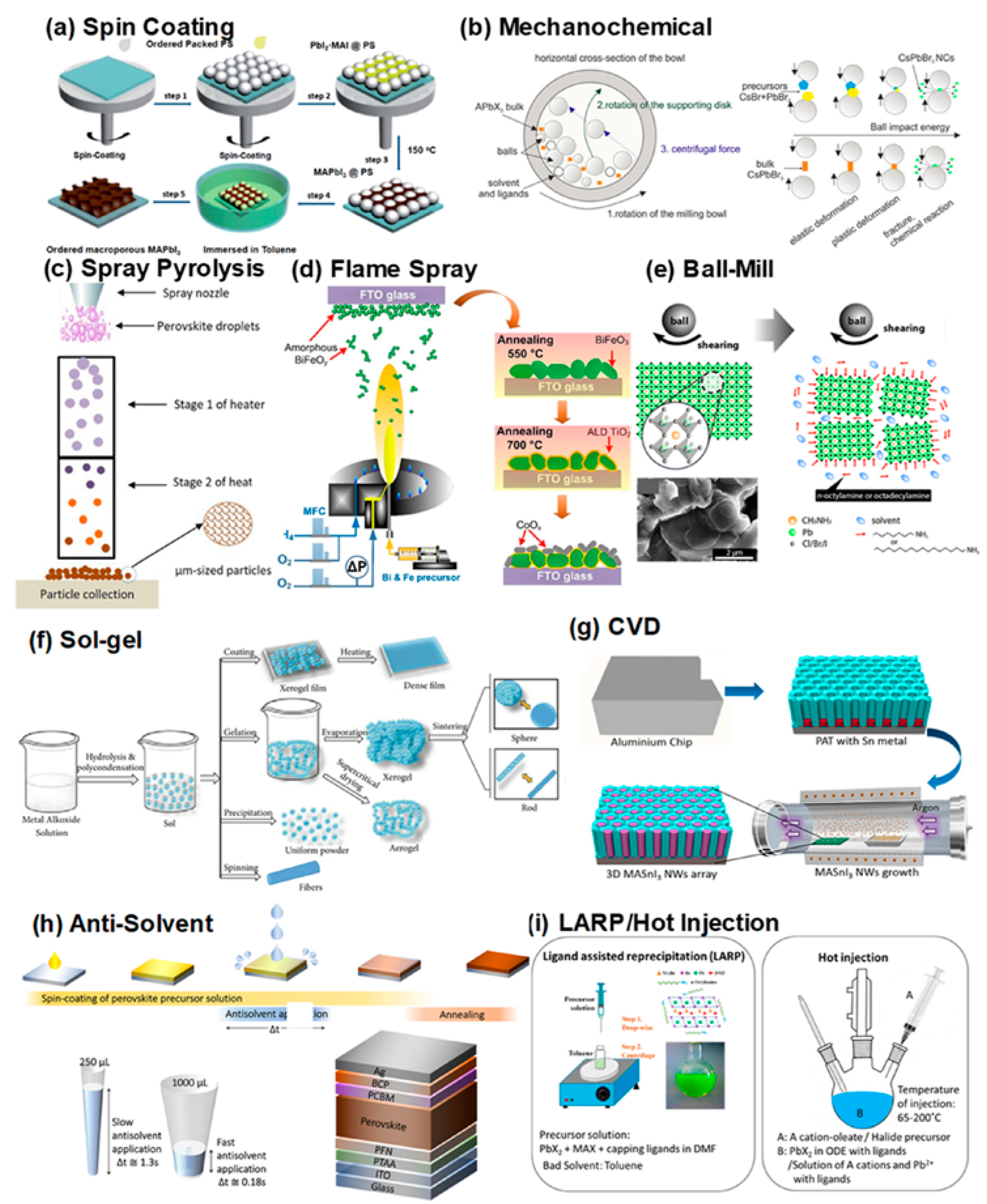
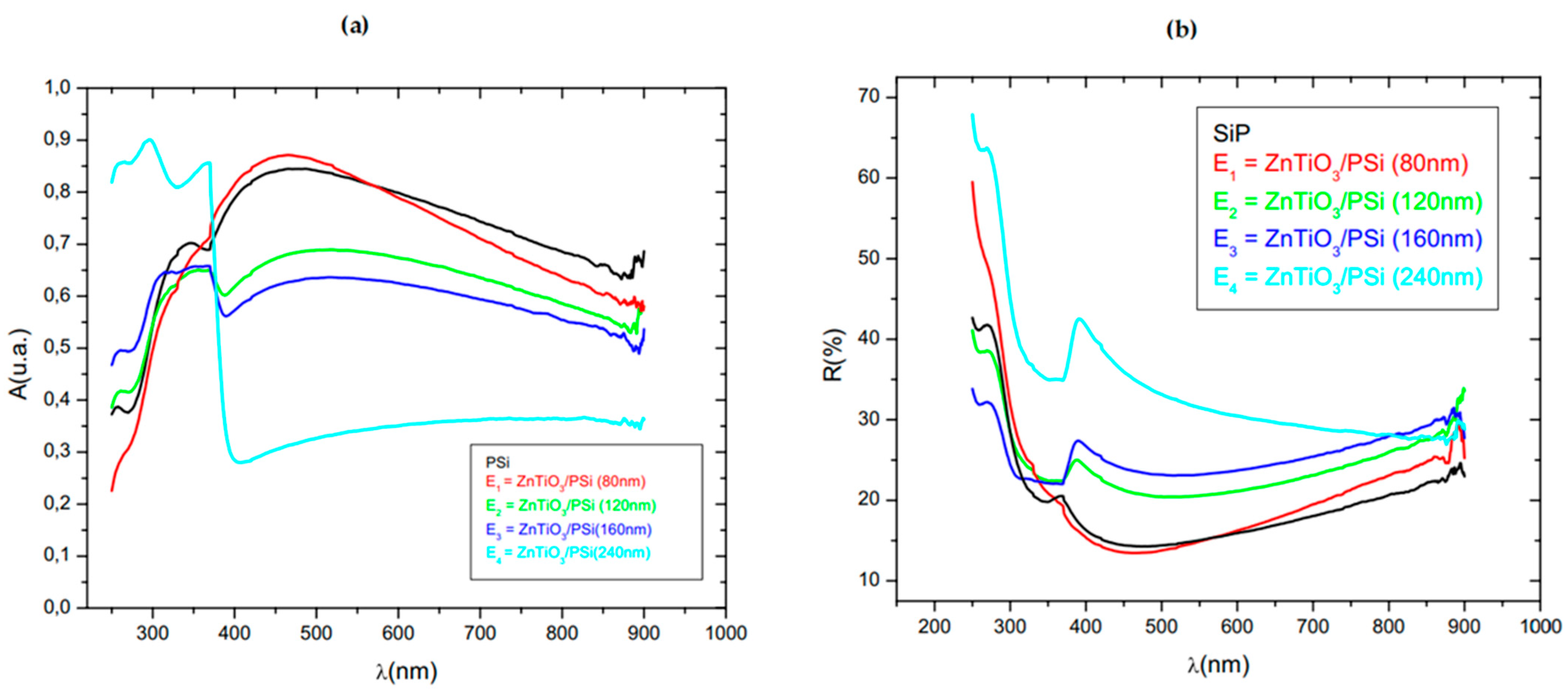

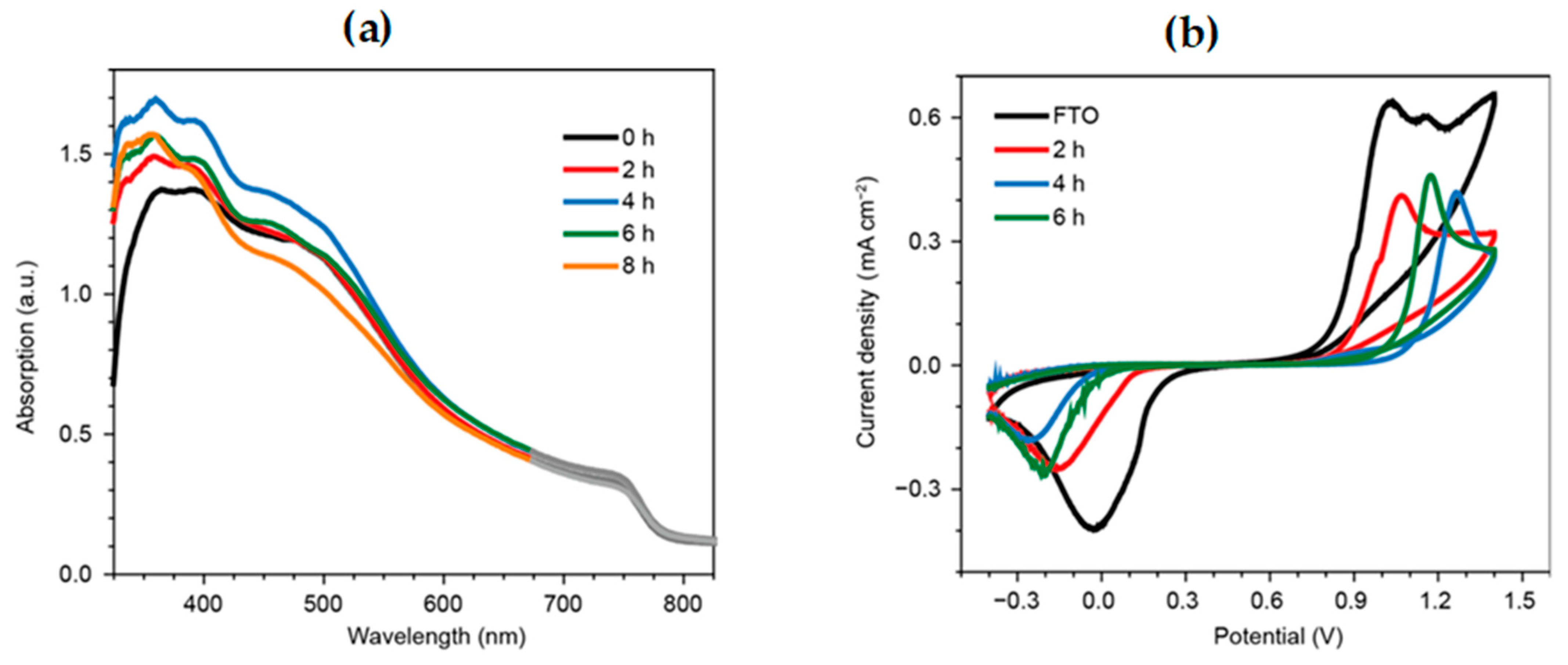

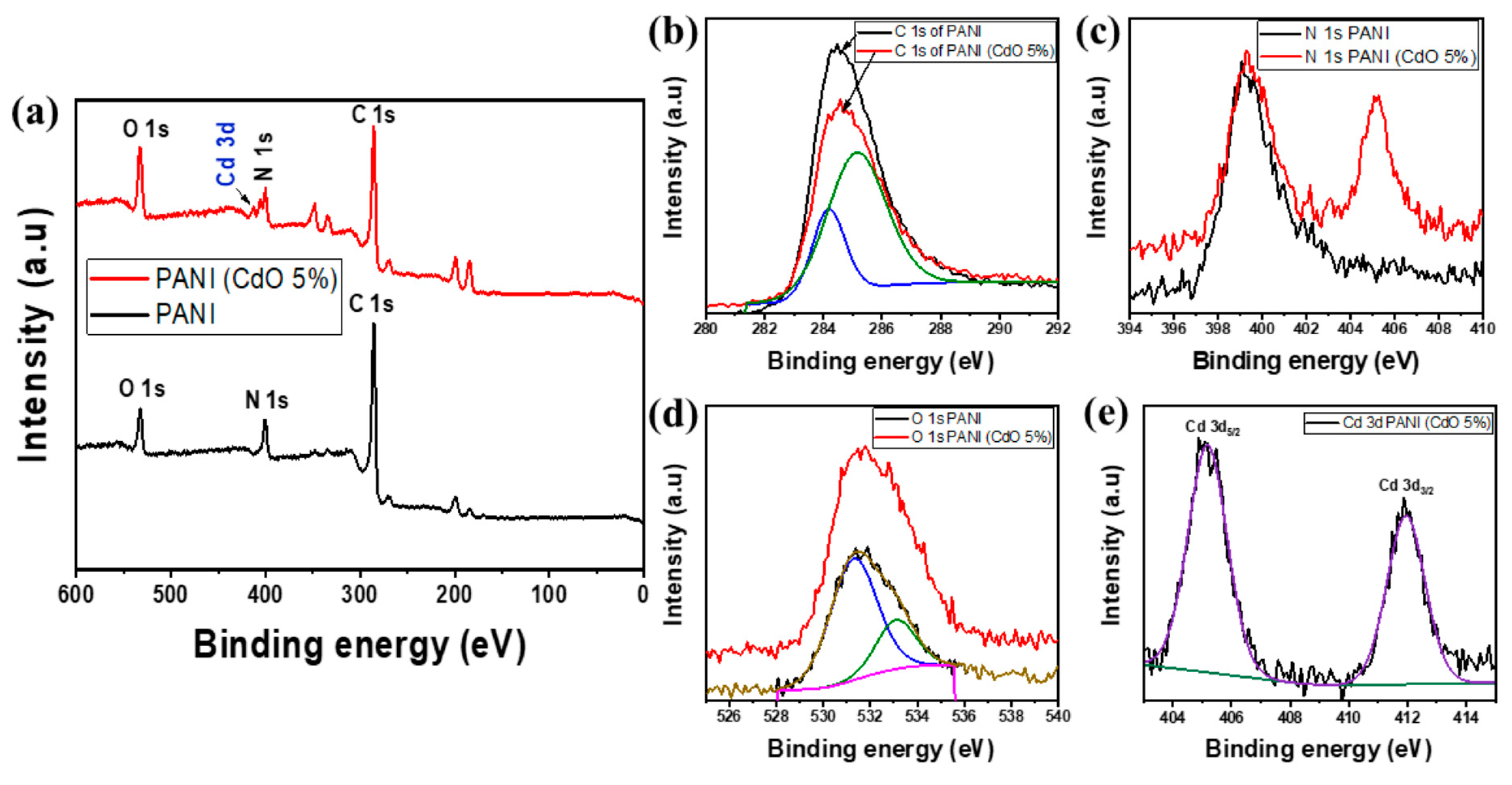
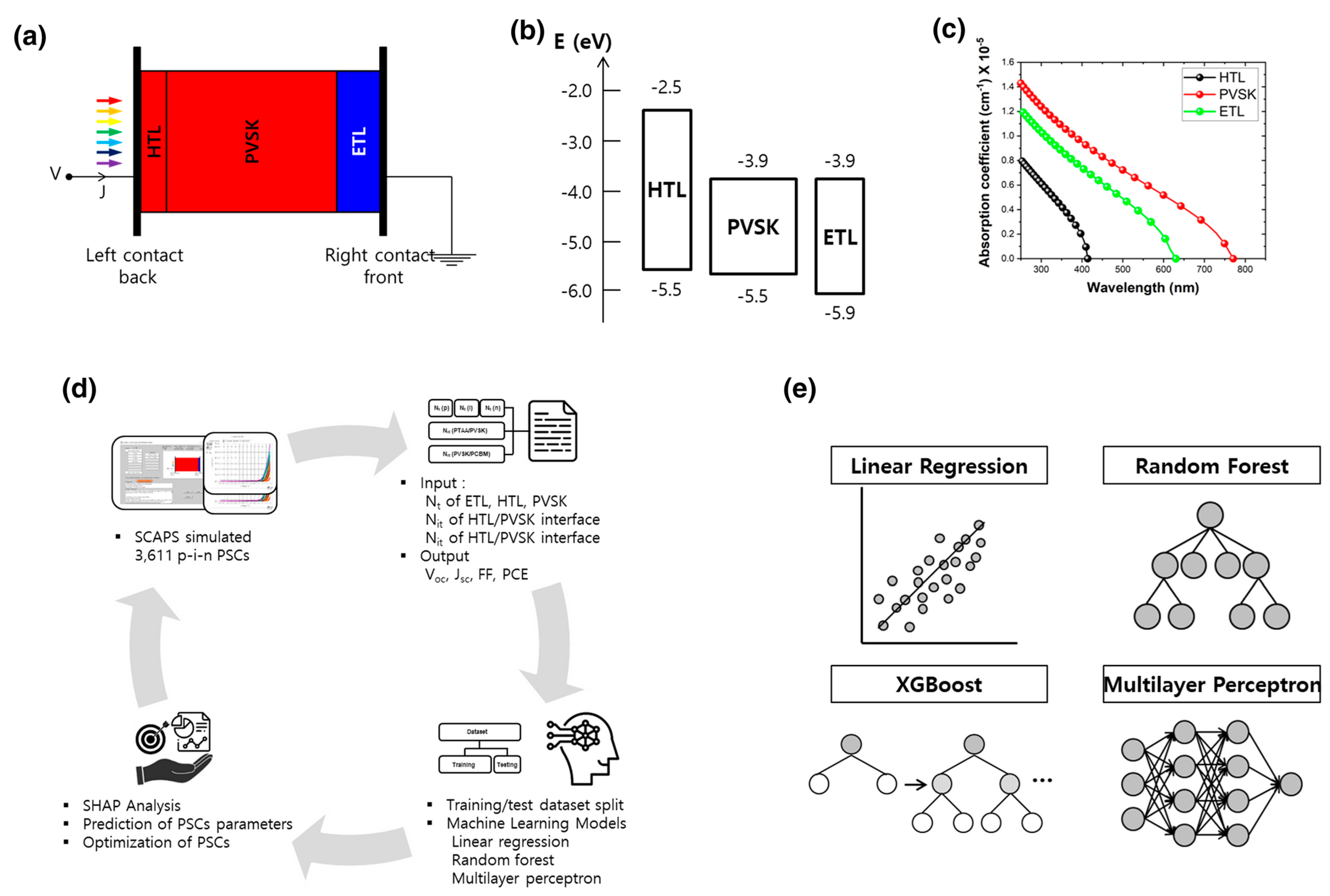
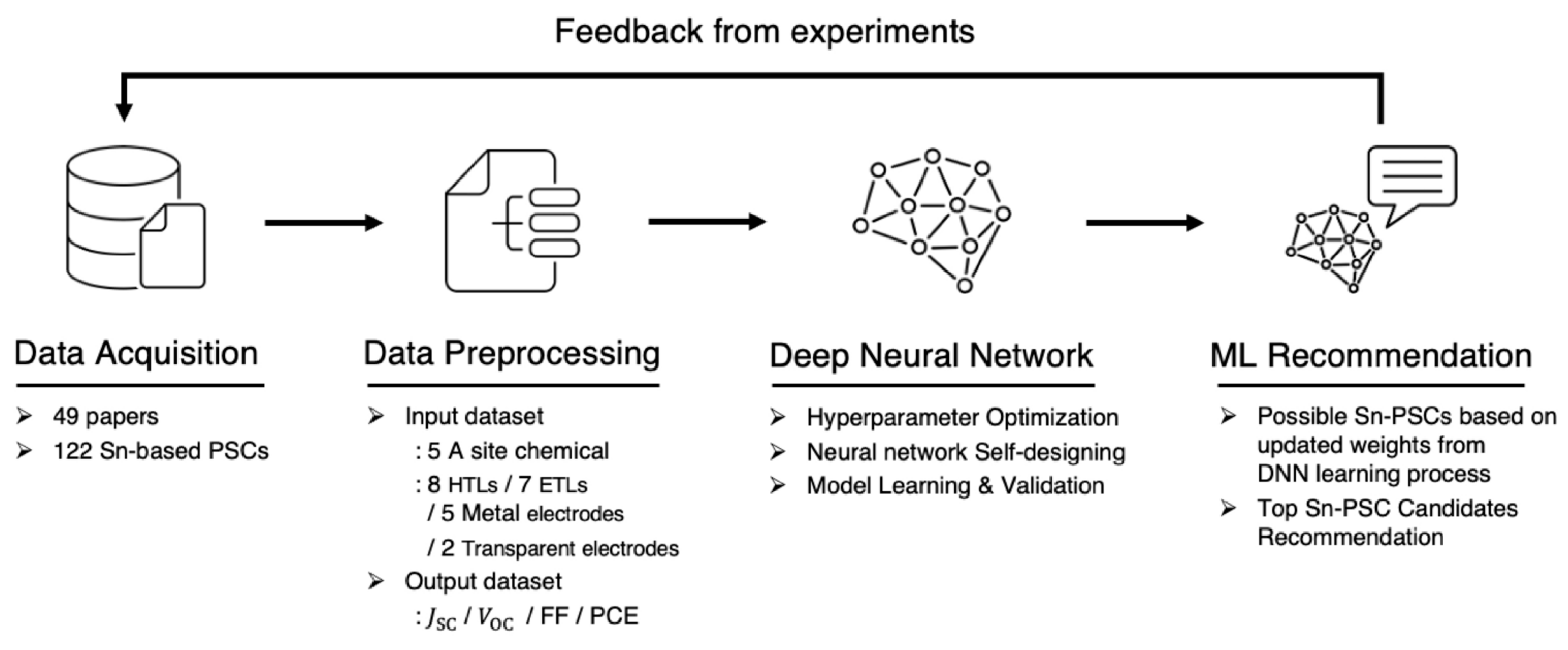
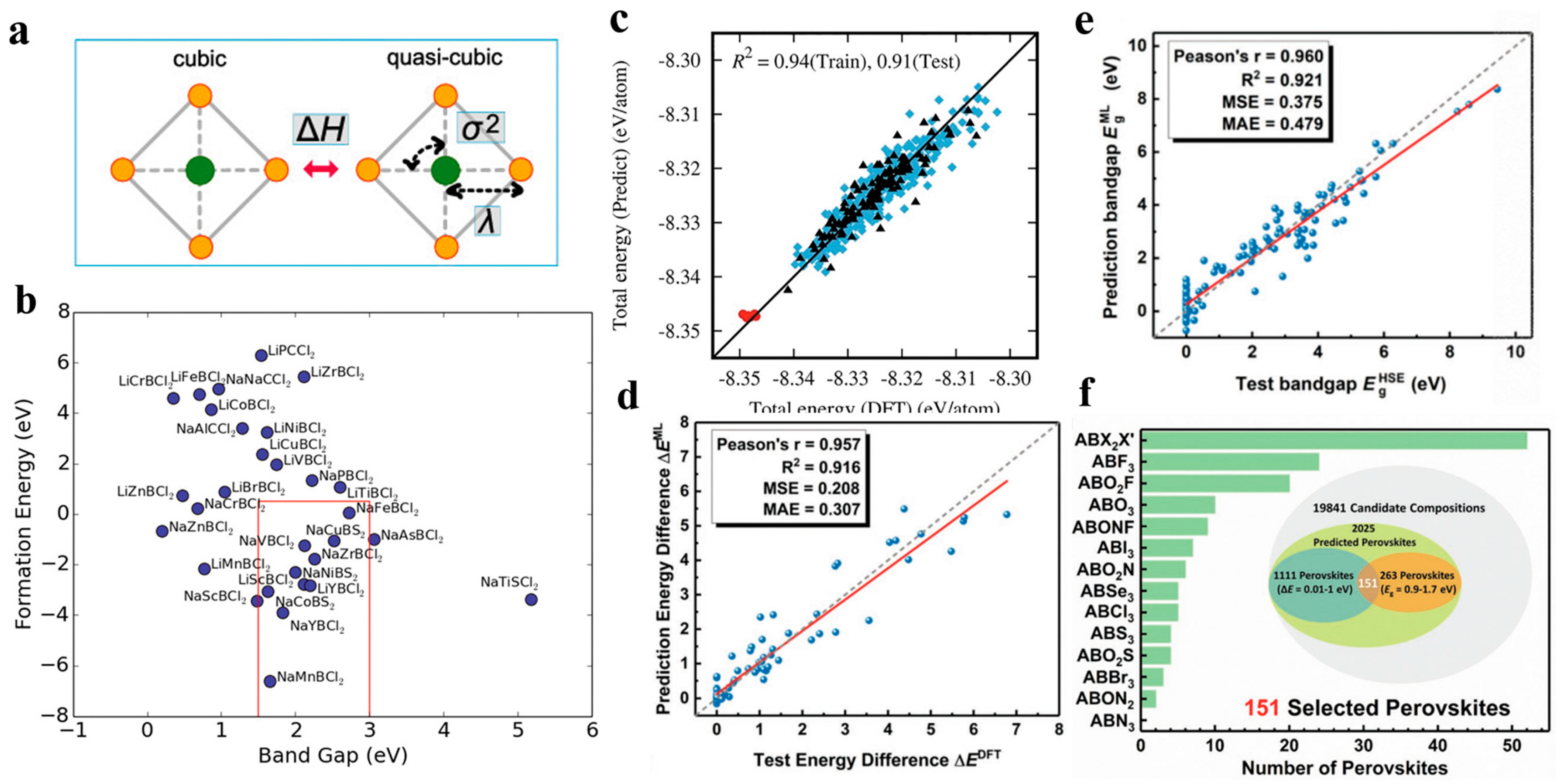
| Category | Technique | Usage |
|---|---|---|
| Structural | X-ray Diffraction (XRD) | Determines crystal structure and phase composition |
| Raman Spectroscopy (RS) | Identifies molecular vibrations and bonding information | |
| Morphological | Scanning Electron Microscopy (SEM) | Examine surface structure and morphology |
| Transmission Electron Microscopy (TEM) | Observes the fine structure and nanomorphology | |
| Optical | UV-Vis Spectroscopy | Measures optical absorption and transmission |
| Photoluminescence (PL) | Assesses light emission properties | |
| FTIR Spectroscopy | Identifies functional groups and molecular vibrations | |
| Electrical and Dielectric | Impedance Spectroscopy (IS) | Analyzes electrical impedance behavior |
| Hall Effect Measurements | Measures charge carrier concentration and mobility | |
| Current–Voltage (I–V) Measurements | Characterizes current–voltage relationship | |
| TSC Measurements | Analyzes charge carrier dynamics at low temperatures | |
| Emerging Techniques | Machine Learning (ML) and AI Integration | Uses data for predictive modeling and optimization |
| Synthesis Method | Advantages | Limitations | Application Areas |
|---|---|---|---|
| Sol–Gel Method | Low-cost, precise control, scalable | Requires post-annealing, moisture-sensitive | Thin films, bulk ceramics |
| Spin-Coating | Uniform films, easy process | Solvent-related defects, pinholes | Solar cells, sensors |
| LARP | Room-temperature processing, tunable nanocrystals | Stability issues, ligand dependency | Quantum dots, LEDs |
| Thermal Evaporation | Pinhole-free films, solvent-free | High vacuum cost, limited material choice | Photovoltaics, electronics |
| CVD | Highly uniform, scalable | Complex setup, high cost | High-performance devices |
| Colloidal Synthesis | Tunable bandgap, high luminescence | Stability concerns, passivation required | LEDs, photodetectors |
| Template-Assisted Growth | Controlled morphology, high charge mobility | Complex template preparation | Nanostructured solar cells |
| Challenge | Current Status | Ongoing Research Efforts | Potential Solutions |
|---|---|---|---|
| Scalability of Production | Small-scale laboratory methods; limited large-scale production | Inkjet printing, slot-die coating, spray deposition | Improve deposition uniformity, optimize processing methods, develop scalable techniques for tandem cells |
| Stability and Durability | Susceptible to degradation from moisture, oxygen, and UV light | Encapsulation techniques, stability enhancement via passivation layers | Use moisture-resistant coatings, develop lead-free perovskites, improve material compositions |
| Toxicity and Environmental Impact | Lead-based perovskites pose environmental concerns | Research into lead-free perovskites, safe recycling processes | Replace lead with safer materials like tin or bismuth, develop safe recycling and disposal methods |
| Cost Reduction | High manufacturing costs in comparison to silicon-based cells | AI-driven material discovery, automation of manufacturing processes | Use machine learning for material optimization, scale production for cost reduction |
| Integration with Other Technologies | Currently limited to PV applications | Research into hybrid perovskite-based energy storage systems, LEDs, and flexible electronics | Develop integrated systems for solar, storage, and display applications using perovskites |
| Long-Term Economic Viability | Initial high production cost, limited industrial adoption | Enhancing efficiency, reducing material costs, improving production scalability | Reduce material and processing costs through innovations in material design, improve performance consistency |
Disclaimer/Publisher’s Note: The statements, opinions and data contained in all publications are solely those of the individual author(s) and contributor(s) and not of MDPI and/or the editor(s). MDPI and/or the editor(s) disclaim responsibility for any injury to people or property resulting from any ideas, methods, instructions or products referred to in the content. |
© 2025 by the authors. Licensee MDPI, Basel, Switzerland. This article is an open access article distributed under the terms and conditions of the Creative Commons Attribution (CC BY) license (https://creativecommons.org/licenses/by/4.0/).
Share and Cite
Tayari, F.; Teixeira, S.S.; Graca, M.P.F.; Nassar, K.I. Progress and Developments in the Fabrication and Characterization of Metal Halide Perovskites for Photovoltaic Applications. Nanomaterials 2025, 15, 613. https://doi.org/10.3390/nano15080613
Tayari F, Teixeira SS, Graca MPF, Nassar KI. Progress and Developments in the Fabrication and Characterization of Metal Halide Perovskites for Photovoltaic Applications. Nanomaterials. 2025; 15(8):613. https://doi.org/10.3390/nano15080613
Chicago/Turabian StyleTayari, Faouzia, Silvia Soreto Teixeira, Manuel Pedro F. Graca, and Kais Iben Nassar. 2025. "Progress and Developments in the Fabrication and Characterization of Metal Halide Perovskites for Photovoltaic Applications" Nanomaterials 15, no. 8: 613. https://doi.org/10.3390/nano15080613
APA StyleTayari, F., Teixeira, S. S., Graca, M. P. F., & Nassar, K. I. (2025). Progress and Developments in the Fabrication and Characterization of Metal Halide Perovskites for Photovoltaic Applications. Nanomaterials, 15(8), 613. https://doi.org/10.3390/nano15080613








